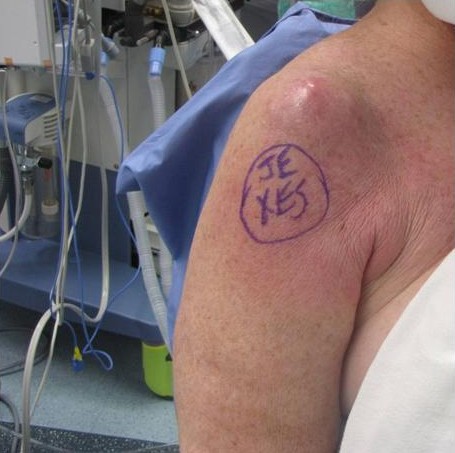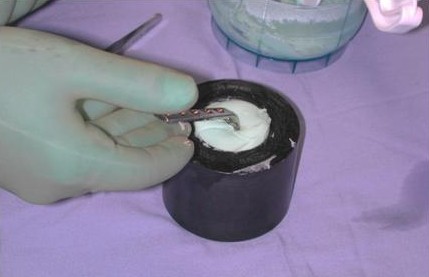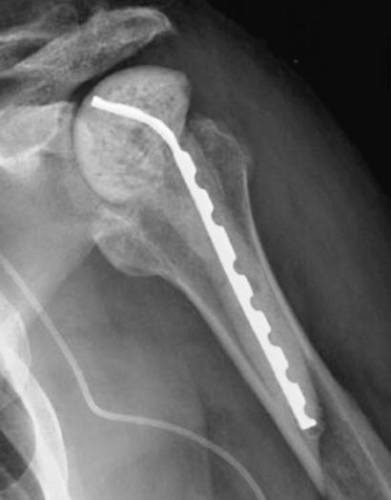PROSTALAC
A treatment for infected shoulder after arthroplasty and other surgery.
Prosthesis of Anti-biotic Loaded Acrylic Cement
(Josef K. Eichinger MD, Paul Yannopolous BA, Jon JP Warner MD) May 2013
Infections in the shoulder joint can occur after a joint arthroplasty procedure. Infections can cause pain and result in loosening of prosthetic components, which may require surgery. Removing an infection can be difficult and in the setting of an artificial shoulder joint is a difficult problem. Sometimes infections are obvious and result in redness, swelling and pain (Figure 1). Sometimes infections are not easily identified and determining the presence of an infection requires careful evaluation and may include x-rays, CT scans, laboratory tests and even biopsies. Once an infection is diagnosed, especially in the presence of a shoulder arthroplasty, surgery is often needed in addition to anti-biotics. Removal of arthroplasty components is necessary because bacteria cling to the components. Since new components cannot be immediately implanted in the setting of an infection a spacer that delivers anti-biotics is used that will allow for shoulder function and treat the infection at the same time. A PROSTALAC device is designed to perform that role.
Figure 1: The above image of a shoulder shows the redness and swelling associated with an infection.
PROSTALAC is an implant designed for implantation into an infected shoulder. It is made of a metal central stem surrounded by cement mixed with anti-biotics (Figure 2). The “head” of the PROSTALAC is formed in the shape of the native humeral head. The humeral head is the “ball” part of the “ball and socket” joint of the shoulder. Medical grade cement is mixed with anti-biotics and allowed to harden in a formed shape that fits into the canal of the humerus (Figure 3).
Figure 2. PROSTALAC creation

Figure 3. XRay showing a Prostalac device
While uncommon, some infections that damage a significant amount of bone and soft tissue may not be able to be successfully reconstructed with a revision arthroplasty. In these rare situations, a resection arthroplasty or removal of the proximal humerus is performed. While function of the shoulder is not normal and diminished, pain is often markedly improved.Stine I.A., Lee B., Zalavras C.G., Hatch III G., Itamura J.M.Management of chronic shoulder infections utilizing a fixed Articulating antibiotic-loaded spacer (2010) Journal of Shoulder and Elbow Surgery, 19 (5) , pp. 739-748.
-A study of 30 patients with infections who underwent PROSTALAC placement. All 30 had clearance of infection. (This should be a link to pubmed.org abstract)
Many patients receive significant pain relief when an infected joint replacement is removed and a PROSTALAC is placed. Some patients still have residual pain after a PROSTALAC and some choose to have another arthroplasty procedure performed after the infection is cleared. In a follow-up study, which we performed,the average forward flexion for the twelve patients with a retained PROSTALAC implant was83 deg (range, 40 degto 130 deg). Four patients had no pain, six patients had mild pain, and two patients had moderate pain.Jawa A, Shi L, O’Brien T, Wells J, Higgins L, Macy J, Warner JJ.Prosthesis of antibiotic-loaded acrylic cement (PROSTALAC) use for the treatment of infection after shoulder arthroplasty.J Bone Joint Surg Am. 2011 Nov 2;93(21):2001-9.
-A study of 28 patients who underwent PROSTALAC. Four patients developed recurrent infection following placement of a PROSTALAC requiring a second PROSTALAC surgery with successful clearance of infection.
Many patients have excellent pain relief and function with a PROSTALAC and do not need further surgery. At least one study has described a group of patients who had good function and pain relief an average of 1.5 – over 2 years after placement of a PROSTALAC.Themistocleous G., Zalavras C., Stine I., Zachos V., Itamura J. Prolonged implantation of an antibiotic cement spacer for management of shoulder sepsis in compromised patients(2007) Journal of Shoulder and Elbow Surgery, 16 (6) , pp. 701-705.
Summary:
Infection is an unfortunate occurrence but the use of PROSTALAC is considered a reasonable method of treatment, with potential for lasting pain relief and, in some cases, acceptable function.
